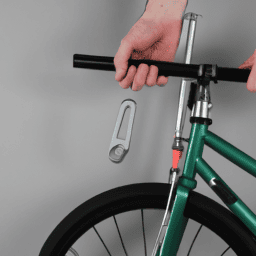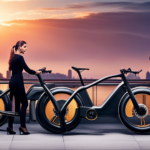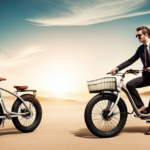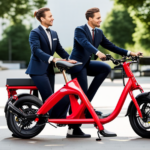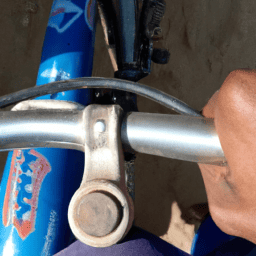Securing your bicycle against theft is a significant worry for bike owners, especially given the increase in bike theft incidents lately. Ensuring your bike stays safe is now more crucial than ever. This article will walk you through selecting the appropriate lock, the correct way to lock up your bike, and extra steps you can take to enhance your bike’s security.
Choosing the right type of lock is crucial in protecting your bike. There are many different types of locks available on the market, and it can be overwhelming to choose the right one for your needs. It’s important to consider the level of security you need, the location where you’ll be locking your bike, and the size and weight of the lock.
By understanding the different types of locks and their strengths and weaknesses, you can make an informed decision and ensure that your bike is properly secured.
Key Takeaways
- Choose a high-quality lock, such as a U-lock, and lock both the frame and wheels to a sturdy object in a highly visible location.
- Avoid weak points like chain-link fences or thin poles, and properly store the lock to prevent it from being easily cut.
- Consider using multiple locks and additional security measures like alarms and GPS trackers to deter theft.
- If your bike does get stolen, file a police report, check online marketplaces, and contact insurance companies for assistance in recovery.
Choose the Right Type of Lock
You gotta make sure you pick the right kind of lock, or else you might as well be handing your bike over to the first thief who passes by.
The two main types of locks are the combination and key lock, and each has its advantages and disadvantages. Combination locks are great because you don’t have to worry about losing a key, but they can be difficult to use if you’re in a hurry. On the other hand, key locks are easy to use, but you have to make sure you don’t lose the key.
When choosing a lock, you should also consider how to properly store it. You don’t want to leave the lock hanging from your handlebars, as it can be easily cut. Instead, store it in a bag or backpack while you ride.
This will also ensure that you have the lock with you at all times, so you can lock your bike up properly. Now that you have the right kind of lock and know how to properly store it, it’s time to learn how to lock your bike securely.
Know How to Properly Lock Your Bike
When it comes to properly locking your bike, I always make sure to choose a secure location that’s well-lit and in plain view.
I then proceed to lock the frame and wheels using a high-quality lock, making sure to loop it through the frame and both wheels.
It’s important to avoid locking to weak points such as chain link fences or thin poles, as they can be easily cut or broken.
By following these steps, I can rest assured that my bike’s secure and protected from theft.
Choose a Secure Location
Opt for a spot that’s well-lit and bustling with people if you want to ensure your bike stays put. This will deter thieves from attempting to steal your bike as they would be easily spotted by passersby or surveillance cameras.
Public locations such as parks, busy street corners, and near public transportation stations are ideal because they offer a high level of visibility. Private locations such as back alleys or secluded areas may offer a more secure feeling, but they also provide cover for thieves to break locks or steal the entire bike.
When choosing a location, it’s important to also consider the object you’re locking your bike to. A sturdy object such as a bike rack or a thick metal pole that’s cemented into the ground is harder to cut through than a flimsy fence or a small tree. Additionally, make sure the object you’re locking your bike to is not easily removable.
For example, a bike that is locked to a chain link fence could easily be lifted over the top of the fence and stolen along with the fence.
By selecting a secure location and locking your bike to a sturdy object, you’re already taking significant steps to prevent bike theft. However, there are still important precautions to take in order to fully secure your bike. Next, I’ll discuss how to properly lock the frame and wheels to make it even harder for thieves to take your bike.
Lock the Frame and Wheels
Choosing a secure location for your bike is only the first step in preventing theft, so it’s crucial to take additional measures such as securing the frame and wheels. Here are some locking techniques that can help you keep your bike safe:
-
Use a U-lock: This type of lock is the most secure option, as it’s made of hardened steel and is difficult to cut or break. Make sure to lock both the frame and the wheels to a sturdy object.
-
Choose a reputable lock brand: Not all locks are created equal, so it’s important to invest in a high-quality lock from a trusted brand. Look for locks that have been tested by organizations such as Sold Secure or ART.
-
Use multiple locks: Using two or more locks can make it more difficult for a thief to steal your bike. Consider using a U-lock in combination with a cable lock or a chain lock.
-
Lock in a highly visible area: Thieves are less likely to steal a bike that’s in a well-lit, busy area where there are plenty of people around.
It’s important to remember that even the most secure lock can be compromised if it’s attached to a weak point.
In the next section, we’ll discuss how to avoid locking your bike to weak points.
Avoid Locking to Weak Points
To keep your bike safe, it’s important to know where to avoid securing it. Identifying weak points is key in ensuring that your bike is secured properly.
Common mistakes to avoid include locking to objects that can be easily cut or broken, such as wooden posts or chain-link fences. Additionally, avoid locking to objects that can be easily removed, such as parking meters or signposts.
Another mistake to avoid is locking to parts of the bike that can be easily removed, such as the front wheel or the seat post. These parts can be quickly detached and the rest of the bike can be stolen.
Instead, try to lock the frame to a sturdy object, and if possible, also lock the wheels. By avoiding weak points and securing your bike properly, you can greatly reduce the risk of theft.
However, it’s important to remember that no lock is completely foolproof. Adding additional security measures, such as using more than one lock or taking the bike inside when possible, can provide even greater protection.
Add Additional Security Measures
One effective way to deter theft is by beefing up your bike’s security measures. In addition to avoiding weak points when locking, you can also install alarms and use GPS trackers to add an extra layer of protection.
Alarms can be triggered when someone attempts to tamper with your bike, alerting you and anyone nearby of the potential theft. GPS trackers can help locate your bike in case it does get stolen. By adding these additional security measures, you increase the chances of deterring thieves and recovering your bike if it does get stolen.
Now, let’s move on to some tips for keeping your bike safe.
Tips for Keeping Your Bike Safe
You want to keep your beloved ride safe from theft, so here are some practical tips to help you do just that. First and foremost, it’s important to have a good quality lock that is appropriate for your bike and the area where you are locking it up. However, even the best lock can fail if it is not properly maintained. Regular lock maintenance, such as lubricating the lock mechanism and checking for any signs of wear and tear, can help ensure that your lock is functioning properly and will not fail when you need it most.
In addition to the lock itself, there are also a variety of locking accessories that can provide an extra layer of security. For example, a secondary cable lock can be used in conjunction with your primary lock to prevent thieves from cutting through the frame or wheels. A locking skewer set can also be used to secure your bike’s wheels and seat. By using a combination of locking accessories and properly maintaining your lock, you can significantly reduce the risk of your bike being stolen.
If, despite your best efforts, your bike does get stolen, don’t panic. There are steps you can take to increase your chances of recovering it.
What to Do If Your Bike Gets Stolen
If my bike gets stolen, the first thing I should do is file a police report. This will help the authorities to track down my stolen bike and possibly recover it.
I should also check online marketplaces such as Craigslist and eBay to see if my bike is being sold.
Finally, I should contact my insurance company to see if my policy covers stolen bikes and if I can file a claim to be reimbursed.
File a Police Report
To report a stolen bicycle, hop on over to the nearest police station and file a report. This is an important step to take as it helps the authorities keep track of stolen bikes and increases the chances of finding it. When reporting the theft, be sure to provide as much information as possible, such as the make and model of the bike, its serial number, and any distinguishing features. It’s also a good idea to bring along a photo of the bike if you have one. After filing the police report, consider contacting local bike shops to let them know about the theft. They may be able to keep an eye out for your bike or offer assistance in finding a replacement.
To increase your chances of recovering your stolen bike, it’s also important to check online marketplaces for your bike. Many thieves will try to sell stolen bikes online, so keeping an eye out for your bike on websites like Craigslist or Facebook Marketplace can be helpful. If you do come across your bike, be sure to contact the authorities and provide them with the necessary information. By taking these steps, you can increase your chances of recovering your stolen bike and prevent future thefts.
Check Online Marketplaces
When searching online marketplaces for a stolen bike, it’s important to note that according to a study by the National Bike Registry, only 5% of stolen bikes are recovered by the owner. However, checking these marketplaces can still be a valuable step in the process of recovering a stolen bike.
Firstly, it’s important to find reputable sellers who are selling the same make and model of your bike. This can help you determine if the bike being sold is, in fact, your stolen bike.
Once you’ve found potential matches, compare prices to determine if the seller is offering the bike at a suspiciously low price. If the price seems too good to be true, it’s possible that the seller is trying to offload a stolen bike quickly.
If you do find your stolen bike being sold, do not confront the seller alone. Instead, contact your insurance company and report the location of the bike to the police.
Contact Your Insurance Company
Contacting your insurance company is a crucial step in the process of recovering your stolen bike, as they can provide valuable assistance and support. Before your bike gets stolen, it’s important to consider insurance options for bike theft prevention. Many insurance companies offer bike theft coverage, which can provide financial protection in the event of theft or damage to your bike.
When your bike gets stolen, contact your insurance company immediately to report the theft and file a claim. Your insurance company will guide you through the process of filing a police report and gathering evidence, such as photos and receipts, to support your claim. Some insurance companies may also offer additional services, such as helping you find a replacement bike or providing reimbursement for bike rental expenses while you’re without your bike.
While insurance coverage may come with a cost, it can be worth it in the long run to protect your investment and ensure that you have the support you need in the event of a theft.
Frequently Asked Questions
What is the best type of lock for my specific bike and location?
For my bike and location, the best lock type would depend on the level of security needed. U-locks and chains made of hardened steel are generally the strongest bike lock materials. Each type has its own pros and cons to consider.
Can I use multiple locks to increase security?
Combining locks can increase security, but it also adds weight and inconvenience. Cable locks are lightweight and easy to carry, but they are also easier to cut than U-locks or chains.
How do I prevent someone from stealing the wheels or seat of my bike?
I use QR skewers on my wheels and a secure seat post clamp to prevent theft of accessories. Anti-theft measures include removing accessories or locking them, but deterrence is key. Recovery strategies should be considered as well.
What is the proper way to store my bike at home to prevent theft?
To prevent bike theft at home, I use bike storage solutions such as DIY bike racks. I position the bike so that it’s not easily visible from the street and secure it with a high-quality lock.
Is it worth investing in a GPS tracker for my bike?
Investing in a GPS tracker for my bike has its pros and cons. Features comparison is crucial, as some models have longer battery life and better tracking accuracy. It’s a personal decision, but I compare the cost to insurance – a necessary expense for peace of mind. Like a compass for a sailor, a GPS tracker can be a reliable guide to finding your stolen bike.
Conclusion
In conclusion, locking your bicycle is an essential step in ensuring its safety and security. Remember to choose the right type of lock, such as a U-lock or chain lock, and to properly secure your bike to a sturdy object. Don’t forget to add additional security measures, such as removing the front wheel or using locking skewers.
Just like a fortress needs strong walls and gates to protect its treasure, your bicycle needs a reliable lock to keep it safe. A bicycle is more than just a means of transportation; it’s a valuable possession that deserves protection. By following these tips and taking necessary precautions, you can prevent your bike from becoming a target for thieves.
Remember, a little effort in locking up your bike can go a long way in ensuring its safety and longevity.
